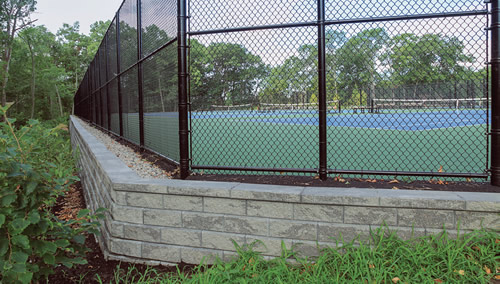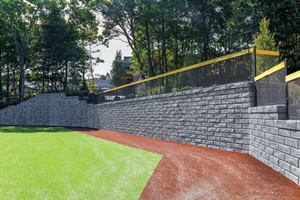Roxbury Latin School

Boston’s Roxbury Latin School undertook a $30-million upgrade to the athletic facilities on its 100-acre campus, which included new tennis courts, baseball diamond, indoor sports complex with a new access road, field upgrades, and landscaping. The terrain at Roxbury Latin School presented several elevation challenges for this massive project. The administrators decided to use two different Unilock wall products to solve these issues. They used the structural retaining wall product to shore up the perimeter of the new tennis courts, creating level playing surfaces on the rocky terrain. And the SienaStone retaining wall materials were engineered to unlock new land by carving the backstop into a hill and creating team dugouts at the school’s Chauncey Baseball Diamond.
Project Snapshot
PROJECT: Roxbury Latin School
LOCATION: Boston, MA
COMPANY NAME: Unilock
WEBSITE: commercial.unilock.com
THE CHALLENGE
In Boston’s West Roxbury neighborhood, Roxbury Latin School undertook a $30-million upgrade to the athletic facilities on its 100-acre campus, which included new tennis courts, baseball diamond, indoor sports complex with a new access road, field upgrades, and landscaping to help buffer the facilities from the surrounding neighborhood. Incorporating all the desired amenities and facilities on an academic campus can be a challenge when the site’s topography includes significant changes in elevation. The terrain at Roxbury Latin School presented several elevation challenges for this massive project.
THE SOLUTION
These obstacles were overcome using two different Unilock wall products in a number of locations. Unilock structural retaining walls can provide solutions by carving out new spaces without compromising aesthetics. In addition, they can be used to create new functional elements in the landscape, such as stadium seating or even an outdoor amphitheater.
 Unilock Concord Wall/Pisa2 XL was used to shore up the perimeter of the new tennis courts, creating level playing surfaces on the rocky terrain. The same wall product was used again to support the load of a new two-lane access road and manage the elevation change between the baseball field and the new indoor athletic facility. At the Chauncey Baseball Diamond, Unilock SienaStone retaining wall was engineered to unlock new land by carving the backstop into a hill and creating team dugouts. This also allowed the diamond to be reoriented for improved solar exposure. Artificial, free-draining turf was installed in most of the athletic fields to allow them to quickly drain between storm events and to improve the quality of storm water from the site, with an added benefit of increasing the life of the playing fields.
Unilock Concord Wall/Pisa2 XL was used to shore up the perimeter of the new tennis courts, creating level playing surfaces on the rocky terrain. The same wall product was used again to support the load of a new two-lane access road and manage the elevation change between the baseball field and the new indoor athletic facility. At the Chauncey Baseball Diamond, Unilock SienaStone retaining wall was engineered to unlock new land by carving the backstop into a hill and creating team dugouts. This also allowed the diamond to be reoriented for improved solar exposure. Artificial, free-draining turf was installed in most of the athletic fields to allow them to quickly drain between storm events and to improve the quality of storm water from the site, with an added benefit of increasing the life of the playing fields.
IMPACT ON LEARNING
Since its founding in 1645, Roxbury Latin has developed an exceptional reputation for its commitment to academic excellence. This expansion project provides students with facilities commensurate with the quality of the rest of their student experience and creates the necessary infrastructure to nurture generations of scholar-athletes.
Editor’s Review
According to the National Federation of State High School Associations (NFHS), participation in interscholastic sports provides high school students with a vehicle that improves their citizenship, sportsmanship, GPAs, self-discipline, and physical and emotional wellness. The competitive experiences prepare them for the future, being part of a team teaches collaboration and expands leadership and time-management skills, keeps them physically fit and, in some instances has been shown to increase GPA scores. By adding the tennis courts and making improvements to the baseball diamonds, Roxbury Latin School was taking steps to help their students succeed.
This article originally appeared in the School Planning & Management April/May 2019 issue of Spaces4Learning.